I was born 1937 in Kyoto City, but many of us were evacuated to rural areas during the war, so I moved to Maizuru (on the Sea of Japan). And, while living as a temporary settler in Maizuru City, my father died in an accident. So, we could not go back to Kyoto, until I completed my high school studies.
In those times, people did not have much to eat, so even children went to work in the fields and farmed. I did all kinds of work there. I mixed compost, sprinkled manure and plowed the fields, and prepared paddy fields. In those times, no pesticides or chemical fertilizer were available. So, we learnt the techniques of organic agriculture when such things did not exist. If that had not been the case, I probably wouldn't be doing this job.
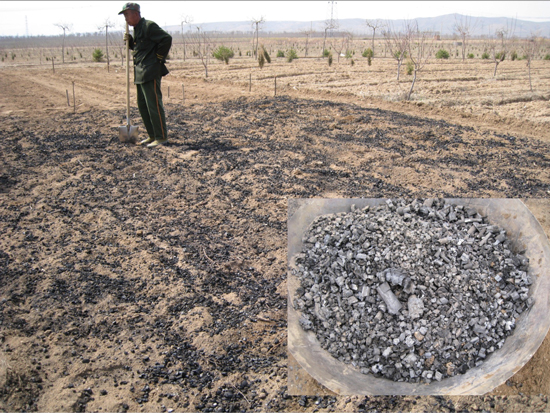
I also used to go to see charcoal making, because it was interesting. It feels warm on the top of the kiln. Charcoal kilns were used in the winter, so I used to go up on the kilns and play there. Charcoal laborers dry their laundry on the top of kilns— it’s kind of like the ondol system in Korea. I learnt through experience how to make charcoal, how to arrange wood logs within the kiln, etc.
Generally, families who owned a mountain had their own yakiko (charcoal burners), who was an expert charcoal maker. They were usually very poor. They cut wood on the mountain and made charcoal at the request of the mountain owner. They took a share of the charcoal as their pay, and sold it in the market. Charcoal making was very harsh and painful work. Sometimes, yakiko had to live in the middle of the woods for months.
On charcoal making in Japan, then and now
It was the same story anywhere in Japan. Charcoal was the only domestic fuel. Charcoal was a kind of luxury item used by urban people. You needed money to buy it. Farmers did not use charcoal. It was a waste of resources. They liked the hearth, in which wood logs are burnt in the middle of the house. Charcoal was used only for kotatsu (table with blanket and heating element on the underside) and it was not so common. In Japan, many people think that charcoal making for agriculture has been done in Japan since olden times, but it’s noteworthy that this is not exactly true. It is unimaginable to think that charcoal was used in agriculture activities. Farmers used only rice husk charcoal as a fertilizer in fields.
At the end of the war, the consumption of charcoal in Japan was about 2,700,000 tons in 1947. That volume was consumed domestically for home and steel making purposes. After that, domestic use of charcoal dropped dramatically, because most of the fuels turned from forest resources to fossil fuels. As to the extent of knowledge on charcoal use in agriculture, there was a period where it gained popularity and consumption increased to about 100,000 tons. However, as soon as the charcoal sales increased, people realized that it was cheaper to import charcoal from abroad and charcoal makers in Japan largely quit.
On mushrooms and his early career
Originally, I had no interest in mushrooms at all. I was not interested in that creepy stuff. That all started with the beginning of my university life. My teacher was working on orchids and matsutake (Tricholoma matsutake, an expensive delicacy), but he was focusing on the mycorrhizal associations among plants and fungi, not the mushroom itself. He asked me to join him. I thought that if I join, I would get to eat matsutake once a year, so I thought “great!” So, that was the beginning.
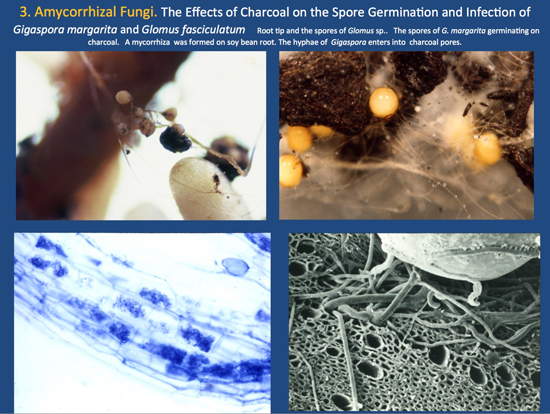
Makoto Ogawa was the first who investigated the interaction of mycorrhizae with biochar.
Because I was a working on matsutake mushroom, I was supposed to examine the ecology and microorganisms of pine forests, so I began to study soil microorganisms. Although matsutake was the starting point, I enlarged my attention little by little to fungal and soil microbial ecosystems. I am the kind of person that continually widens my interests.
I received some attention from a professor, Dr. Rokuya Imezaki, who worked at the Forestry Experiment Station (at that time it was located in Tokyo) which is now known as the Forest and Forestry Research Institute (located in Tsukuba). He was an authority on fungal taxonomy. Anyway, he had strong interest in fungal ecology and encouraged my work. Once I entered the Forestry Experiment Station, I found it to be an easygoing place and I was free to do anything. I was told, “You can do anything you want. But, there are no research funds, so you have to find some on your own.” So, I could do anything I liked.
An American plant ecologist, Dr. J. Franklin had come to the laboratory after I had been there for about two years. He came from a USDA laboratory near Oregon State University. We were of same age, so we talked a lot in broken English and broken Japanese. And, he asked me to come to America to join the International Biological Program (IBP), so I went from March 1972 to March 1973 with my family. And it turned out to be an immensely good experience. During this stay term I could learn about Arbuscular mycorrhiza from Dr. J. Trappe and investigate the fungal ecology in coniferous forests of the Cascade mountains. I was asked to stay one more year in America, but when I was going to extend my stay, I was told, “If you stay any longer, you’ll lose your job in Japan”. In those times, there were hardly any jobs for university graduates, especially in agriculture. So I had no option but to go back to where I have a position to work, and returned to Japan to avoiding being fired.
So, I lived and worked in Tokyo continuously for 10 years, and a year before the Institute moved to Tsukuba, Mr. Ginji Sugiura came to me and said “Could you investigate something on charcoal?” He explained to me, “Charcoal seems to help trees growth well, and some people suggest that charcoal application would be beneficial for agriculture crops. But I don’t know the reason behind it, I think some microorganisms are involved in this process. Could you research this? So, I was really moved to work on biochar at the request of others. Once I started researching things, it got really interesting.
When we had moved into the new building in Tsukuba, Mr. Sugiura once again came and asked me to take a look at something. He said “I have brought a pine tree from the sea coast”. It was an uprooted tree, in its entirety including the roots. It was as tall as a man. Its roots were all black with charcoal. He said “I used very fine charcoal. With the application of charcoal, this tree has grown this much! When I talked to you last year, it was much smaller.” When I took a closer look, I found something inside the black charcoal that seemed like a lot of white entangled threads. I knew right away and said “Sugiura san, it’s the mycelia of Rhizopogon rubescens, it’s Rhizopogon rubescens.
Charcoal and fungi relationship
Immediately we rented a place near the sea coast and started our experiments. We needed to explain the relationship between the charcoal and Rhizopogon rubescens. And it was then that I was approached by the Ministry of Agriculture, Fisheries, and Forestry to join a research project on the utilization of natural energy through soil microorganisms as a microbiologist in the Ministry. At that point in time, I knew about Rhizopogon rubescens, so I thought if charcoal worked so well with trees and roots, then perhaps it would work well with soybeans too. Why I came to think of soybean is because I remembered those times when I used to live in the country and enjoyed farming.
In old times, farmers used to make a triangle ridge on the border of their paddy fields. Then, they would make a hole in the ridge with a hoe and fill it with ash. They brought ash from their hearth or bath furnace—it was wood ash and cinders. And, just by applying a bit of mud to it and planting soybean seeds, they yielded a good crop. Practically everyone used to do this practice. It’s also done in Korea and in some provinces in China. I realized that what the farmers saw as ash was not just ash, but must’ve contained small pieces of charcoal. Inspired by this speculation, I immediately conducted experiments on soybeans. I started experiments on the very same day I remembered this. In the end, I found many root nodules developing. They come without fail, any bean, gathering around the pieces of charcoal. I proved this through my experiments. So, in a way, charcoal is very attractive to the roots of a plant. It was magical when we pulled the soybeans out from the soil and found root nodules developing on the charcoal so frequently.
The inside of charcoal is clean. Even cinders do not have any microorganism inside of them. So, it’s more of an empty house and hollow space. Only bacteria exist there, but not saprophytes, the bacteria that survives on rotting things. Only symbiotic bacteria would migrate to the charcoal. And we used powdered bark charcoal, not wood charcoal in my first experiment. It's different from wood charcoal because of its properties. It has more minerals and its structure is different. I might call it coarse or rough, but it was really varied in size and shape, which I think is important. Fine particles are good for bacteria. The rough and big particles with pores are good for fungi. And, the pH value of bark charcoal is lower, about 8, compared with wood charcoal.
Another factor was that the soil in Tsukuba was good for charcoal research. Our laboratory was built by clearing a pine forest and the soil there was very bad. It was volcanic ash loam with a reddish brown color. We were lucky. If I had not done the experiments on that land, I would not have gotten that result. The agriculture specialist told us, “The nutrient level is extremely low in the soil that Ogawa san used. If it was our field, it would not have produced the same results. ”
On cultivating with charcoal
First of all, you need to consider the type of charcoal. The properties of bark charcoal don’t change much, bark charcoal from deciduous trees or broad-leaved trees seem to be almost same, but bark charcoal from coniferous trees is not so good. It becomes a fine powder. There are fewer fibers in it. Deciduous tree bark generally has more fibers, so they make a rough-surfaced charcoal.
Although we did not use bamboo charcoal in the beginning, we experimented with several materials like rice straw, bean cakes, etc. We were working with rice husks also. Rice straw was not good. It had hardly any impact. I knew that it contained phosphoric acid, but it had no effect on the fertility of the soil and there was no microbial effect either. It vanished when we ploughed the fields. It broke apart into fine pieces too easily. Also, its structure was different. It had no holes in it. Rice husk charcoal is not porous, either. It had small pores, but not big pores. It is good for bacteria but not good for fungus.
I used a little bamboo charcoal too. I got it from Mr. Sugiura not knowing what kind of charcoal it was and used it for tree seedlings. The trees died. So, that was not good. It was too alkaline, about pH 10. However, if shirozumi (white charcoal from wood) is mixed in the soil as a powder, not as a mass, it will benefit bacteria propagation such as Rhizobia and create more root nodules.
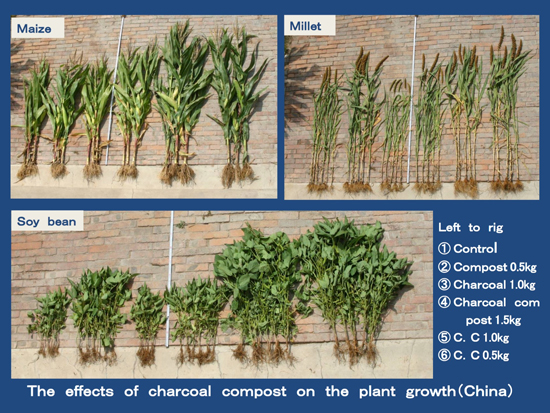
When others still wrote for another ten years project propals for trials with 25 tons of pure biochar per hectar, Makoto Ogawa published his results on blending biochar with compost.
So, the effect of charcoal on the soil depends on various factors, such as the feedstock, how the burning was conducted and at what temperature, and the size of the feedstock when charred. Many factors interplay with each other, so it is a very complex process. And, don’t forget about the soil type. Our experiments were conducted in volcanic ash soil only because I was in Tsukuba, so it is hard to say what would have happened in another soil type. It will work differently in sandy soil. I know of experiments that have worked well in clay type soils, and I’ve confirmed this with my own experiments. It works even better with sterile red soil, or so-called Laterite in tropical region. And it also works well in yellow soil found in China.
And I’ve found that it doesn’t make any difference if the soil is dry or wet. However, if we apply charcoal in dry soils, like in Australia where it hardly rains, the charcoal would absorb all the water. It releases water back to the soil when it becomes completely dry. If you apply a lump of charcoal, it is immensely powerful at absorbing water. Nearby plants just can’t compete for water and sometimes they even wilt. The roots of agricultural crops spread out within a very small area, so even if you mix the charcoal in the soil, chances are high that it will make contact with charcoal. However, the roots of a big tree spread out if you don’t use larger amounts of charcoal. It will not be so effective. You have to figure out whether charcoal should be right under the seedling itself or near the roots. Application near the roots allows for mycorrhizae to develop. If you just randomly bury charcoal or spread it superficially around at the time of tree planting, it would never be as effective.
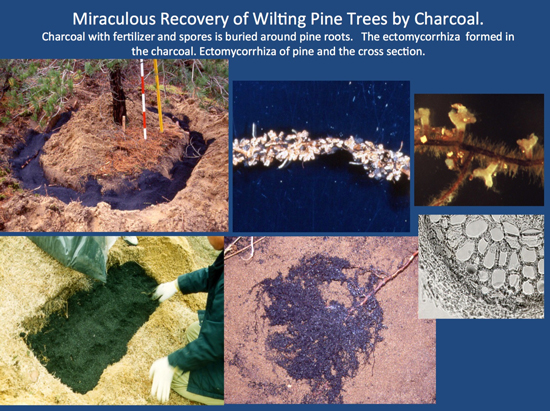
And he pioneered tree planting and tree sanitation with biochars already in the last century.
The same story is true with agricultural crops. Here too we can categorize crops into those that encourage arbuscular mycorrhiza grow and those that don’t. Members of the Brassica family, like cabbage, Chinese cabbage, radishes etc. don’t seem to do well. But there are always improvements in soil quality, especially in clay soils, so that can help with root growth even for Brassicaceae, for example Kameoka cabbage. For plants that develop arbuscular mycorrhiza, such as eggplant, tomato, and cucumber, a careful application of charcoal can be very effective.
Charcoal is most effective with leguminous plants, since both rhizobia and arbuscular mycorrhiza develop with them. After that cucumber, eggplant, and tomato, which are all in the nightshade and Cucurbitaceae. Charcoal also, unexpectedly, works on sweet potato. It’s the same with strawberry and green onion. We have the research to back it up. The interesting fact about green onion is that sometimes rice husks are more effective than charcoal, because of the arbuscular mycorrhiza fungus called Glomus which grows on the roots of green onion. Glomeromycota produces arbuscular mycorrhiza, but seems to like the chaff more than charcoal. If we start to find out every single detail of this kind it would be very complicated work as there are a great number of combinations. For example, the other day, I tried an experiment in China with soybean, corn, and millet. Both millet and corn belong to the grass family, Poaceae. However, the charcoal application showed good results with the corn, but did not work at all with the millet. Results are different even in the same group of plants. I don’t understand why such things happen. That is why I have never wanted to say with confidence that “charcoal is good” for something. You just need to be able to think carefully about how to use charcoal in certain situations— that is enough.
Historical Use in Japan
In olden times, only a few outstanding farming families used to make charcoal. That is why we can find old agricultural documents from the Edo period (1603-1867) that mention the usage of charcoal like substances. They seemed to have made it using a steaming technique. The nousho (old agricultural books) from the Hiroshima region has a good explanation on it. They used to apply charcoal very efficiently and this was a rarity I think. The technique was transmitted as a family tradition. They used to bring mounds of grass and small branches down from the mountains, dry and store them in a hut used for storing ash, then mix them with mud paste, pile them up again outside of the hut to create many layers, and finally burn the whole thing in a slow fire. Covering the mound with mud paste decreases the chances for a larger fire to develop and carbonizes the wood more efficiently. With this method, ash, charcoal, and burnt soil would be created after several days. They would mix it with manure, or human excrement and urine, to make a fertilizer. It must have been an extremely time consuming practice.
Another method also written in the nousho explains the same, which is to use steam-roasting. I think it is an easier method than the ash mound technique and it does not say you should only use wood ash or charcoal. It simply states that steam-roasted litter is effective. It also says that black charcoal keeps aphids in check with eggplant by applying black charcoal straw near the roots. We replicated this in Tsukuba and it was true. Old agricultural documents like this are incredible and it is interesting to try and replicate the findings. The Nougyou Zensho (“The Complete Agricultural Reference”) written by Yasusada Miyazaki is the most detailed, the easiest to understand, and easiest to find information in as everything is clearly labeled.
When I was first thinking of publishing this work with charcoal, or at least the experiment on Rhizopogon rubescens and soybeans, I was a little worried. I was worried if my work was really new or if it had been already done in the Edo period. So I searched the Nougyou Zensho and when I looked through the section on soybeans, I found an entry on “ash feces.” It said, “roast anything, mix it with human excrement and urine, and apply it— this works with anything.” Apparently, the method was first used during the “Genroku Era” (1688-1704).
I think farmers in those times used fire very often and in many ways beyond just making charcoal, like controlled burns. However, burning fields is banned in Japan now and you would get in trouble if you did it. They also made and used various types of fertilizer beyond ash and excrement types. For example, grass fertilizer is made from the roots of grass. Written documents say “scrape the surface of the soil taking just the upper layer and mix it in the soil of your fields.” This practice focuses on arbuscular mycorrhiza and bringing the spores of beneficial root nodule bacteria to your soil. Mud is another way- if you add sludge to the soil then this kind of bacteria would come for sure. It is similar to agricultural technology used by people in South America and the Amazon.
So, these old agricultural techniques were really important for everyone all over the world, not only in Japan. In those days, only the smartest individuals worked on developing agricultural techniques since they were essential everywhere. But now, things have worsened as people with less intelligence are doing it. (Laughs)

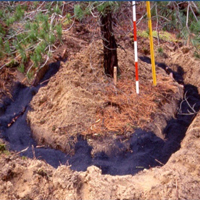
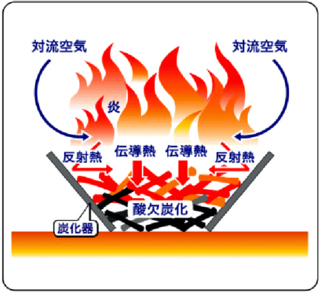
Biochar Structure
What a refreshing article to read. My experience testing biochar agrees well with your observations. Your discussion of particle size and structure is very parallel with my own experience. Many people tell of results of applying "powdered" biochar to agricultural soils. Others talk about using biochar from wood pellets. My experience would advocate otherwise. I would prefer to apply "chunk" biochar, like that obtained from wood chips - maybe 1/4 inch mesh or even larger. Powdering or compacting destroys the macrostructure of charcoal, and I contend that the macropores are the sites of biological interactions. Powdering or compacting may allow the adsorptive properties to continue, but it destroys the ecological niches that play host to microorganisms and active biological macromolecules. Thank you for writing the article. It's very encouraging for my research program. Dan Young PO Box 99 Hyde Park, VT, USA 05655 Phone (802) 888-4675 Cell (802) 730-6899